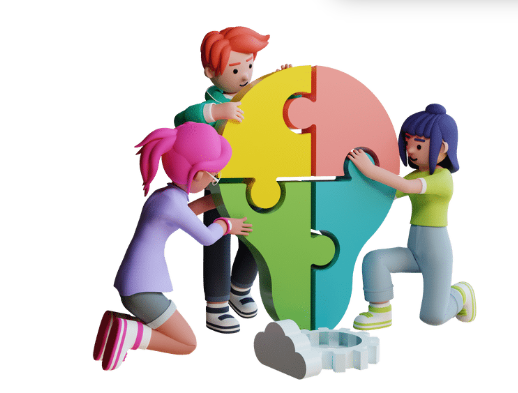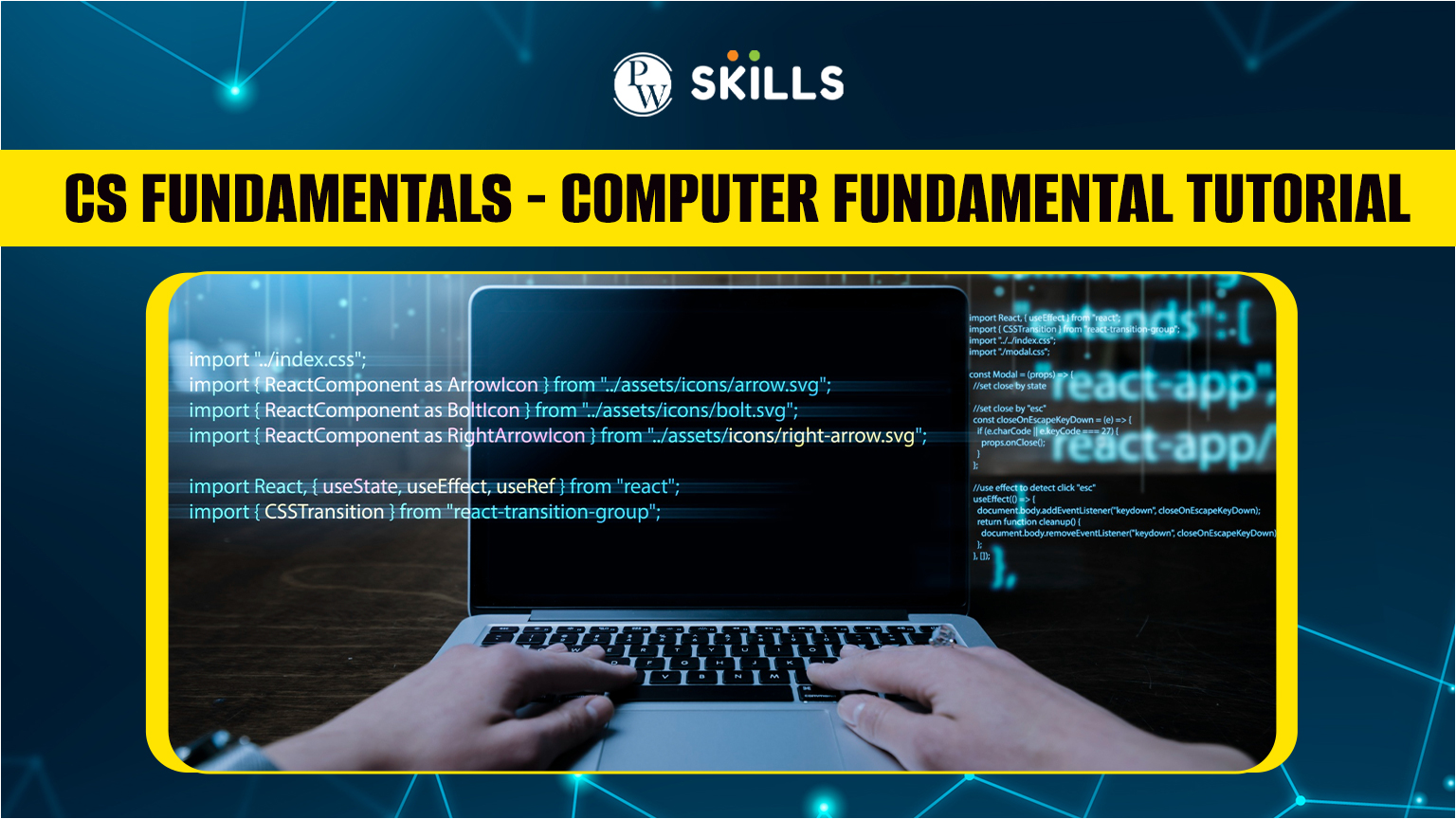CS Fundamentals or Computer Science Fundamentals is a tutorial that covers everything from basics to advanced concepts related to computers. Whether you are a beginner or working professional you can start from the basics.
This tutorial is especially prepared to enhance your knowledge of computers, its components, softwares, hardwares, algorithms, hardwares, etc.
Also, check Basic Computer Coding Tutorials for Beginners
What is a Computer?
Computer is an advanced intelligent electronic device used to perform a wide range of tasks from storing data, calculations, communication, information processing, hosting applications, and more. Computers consist of hardware, software, I/O, storage devices and others which can easily integrate with computer systems.

Evolutions of CS Fundamentals
The evolution of computers dates back to the early 90s which covers the development of electronic computers to advanced artificial intelligence computer systems.
| Generation | Period | Technology | Examples |
| First Generation | 1940s – 1950s | Vacuum Tubes |
|
| Second Generation | 1950s – 1960s | Transistors |
|
| Third Generation | 1960s – 1970s | Integrated Circuits (ICs) |
|
| Fourth Generation | 1970s – Present | Microprocessors |
|
| Fifth Generation | 1980s – Present | Artificial Intelligence (AI) and Quantum Computing |
|
| Sixth Generation | 2000s – Present | Cloud and Edge Computing |
|
CS Fundamentals: Physical Components
The physical components of a computer system consist of several hardware devices as mentioned below.
- Central Processing Unit (CPU): It is popular as the brain of the computer, responsible for executing instructions and processing data.
- Memory (RAM): It is a temporary storage that holds data and instructions currently in use.
- Storage: Permanent storage for data and programs, such as hard drives (HDDs) or solid-state drives (SSDs).
- Input Devices: Input devices are tools used to enter data into the computer, such as keyboards, mice, and scanners.
- Output Devices: The output devices are omponents that present data to the user, like monitors and printers.
Also, check, How Data Storage in Computers take Place?
CS Fundamental: Software Components
The Software components in Cs fundamentals are components of computers which pass instruction to the hardware to perform a specific task. Operating systems such as macOS, Windows, Linux, etc are some examples of softwares in Computer systems.
Introduction to Programming
A programming language is a set of instructions which is used to create software programs. There are many popular programming languages used around the world such as C, C++, Java, Python and more. Programs are a set of instructions which runs a program to execute a specific task.
Learn Data Structures in programming language which is a method of organising, processing, storing data. Linked List, array, Stacks, Queues, graphs, etc are some of the examples of data structure.
- Array: An array is a collection of elements identified by an index or key. It provides faster access to elements and is fixed in size. An array is a group of similar elements.
- Linked Lists: A sequence of nodes having connection to the next nodes using the reference to the next node.
- Stacks: A collection of elements that follows the Last In, First Out (LIFO) principle. Operations include push (add) and pop (remove).
- Queues: A collection of elements that follows the First In, First Out (FIFO) principle. Operations include enqueue (add) and dequeue (remove).
- Heaps: This is a hierarchical structure connected by edges. Binary Trees, Binary Search Trees, AVL trees are some of the examples of heaps data structure.
- Graphs: It is a collection of nodes and edges interconnected to each other. Directed graphs, undirected graph, and weighted graphs are some of the popular examples.
Also, check Types of Trees in Data Structures
Applications of Computer Fundamentals
There are a wide range of applications of computer fundamentals in various fields.
1. Data Analysis
Computer fundamentals, including algorithms and data structures, are essential for efficiently processing and analyzing large datasets. Understanding how to manipulate and interpret data using data analysis allows organizations to extract valuable insights, enabling informed decision-making and strategic planning.
2. Artificial Intelligence (AI)
Foundational knowledge in computer science is crucial for developing AI systems, as it encompasses programming, machine learning algorithms, and data handling techniques. These fundamentals enable the creation of models that can learn from data, recognize patterns, and make predictions, driving advancements in automation and intelligent applications.
3. Software Development
Understanding computer fundamentals is vital in software development, as it involves principles of programming, system architecture, and software design. These concepts guide developers in creating efficient, maintainable, and scalable applications, ensuring that software meets user needs and performs optimally.
4. Cybersecurity
Computer fundamentals provide the essential knowledge needed to understand system vulnerabilities, encryption techniques, and network protocols. This understanding is critical for designing secure systems, implementing effective defence mechanisms, and responding to security threats in an increasingly digital world.
5. Network Administration
Fundamental concepts in networking, such as protocols, topologies, and configurations, are crucial for network administrators to effectively manage and maintain network infrastructure. A solid grasp of these principles ensures reliable connectivity, performance optimization, and security within an organisation’s network.
6. Cloud Computing
Computer fundamentals underpin the principles of virtualization, distributed systems, and resource management in cloud computing. This knowledge allows organisations to leverage cloud technologies effectively, optimising resource use, enhancing collaboration, and ensuring data accessibility and security.
7. Database Management
A strong understanding of computer fundamentals, including data models and query languages, is essential for effective database management. This expertise allows professionals to design, implement, and maintain databases that ensure data integrity, accessibility, and efficient retrieval.
8. Web Development
Web development relies on computer fundamentals like programming languages, protocols, and user interface design principles. These foundational skills enable developers to create responsive, interactive websites and applications that enhance user experience and meet business objectives.
9. Game Development
In game development, computer fundamentals are crucial for understanding graphics programming, physics simulations, and AI implementation. This knowledge allows developers to create immersive and engaging gaming experiences that leverage computational techniques for realistic gameplay.
Important CS Fundamentals Interview Questions

Let us check some of the important CS fundamentals interview questions which every beginner must be aware. Prepare questions releated to every topic under this article to strenghten your basics of computer systems.
Q1. What is the CPU?
The Central Processing Unit (CPU) is the brain of the computer, responsible for executing instructions.
Q2. What are memory units in a computer?
Memory units store data temporarily or permanently, such as RAM and hard drives.
Q3. What is a QWERTY keyboard?
A QWERTY keyboard is the most common keyboard layout based on the first six letters in the top row.
Q4. What are peripheral devices?
Peripheral devices include external input and output devices such as a mouse, keyboard, monitor, and printer.
Q5. What is the difference between ALU and CU?
The ALU (Arithmetic Logic Unit) performs calculations, while the CU (Control Unit) directs operations within the CPU.
Q7. What are the types of software?
There are two types: system software (e.g., OS) and application software (e.g., word processors).
Q8. What is the difference between SRAM and DRAM?
SRAM is faster and more expensive, used for cache memory, while DRAM is slower and used for main memory.
Q9. What is malware?
Malware is malicious software designed to harm, exploit, or otherwise compromise a computer system.
Q10. What is encryption?
Encryption is the process of converting data into a coded format to prevent unauthorised access.
Q11. What is Artificial Intelligence (AI)?
AI is the simulation of human intelligence in machines, enabling them to perform tasks that typically require human intelligence.
Q12. What is an artificial neural network (ANN)?
ANNs are computational models inspired by the human brain’s structure, used in AI for recognizing patterns and making predictions.
Q13. What is cloud computing?
Cloud computing is the delivery of computing services (e.g., storage, processing) over the internet, allowing access to data and applications remotely.
Q14. What are the three main types of cloud computing services?
The three main types of cloud computing are Infrastructure as a Service (IaaS), Platform as a Service (PaaS), and Software as a Service (SaaS).
Learn CS Fundamentals with PW Skills
Strengthen your knowledge of basics of computer programming and fundamentals with PW Skills Computer Science And Programming Fundamentals Course. Learn HTML, Linux, CSS and more with interactive classes and hands on training.
This is a 12 hour recorded upskilling program where you will learn about the computer science fundamentals, web development, and more. Also, get a certification in computer fundamentals at the end of the course. Master Linux, HTML, CSS, and other important concepts of computer systems.
CS Fundamentals FAQs
Q1. What are CS Fundamentals?
Ans: Computer fundamentals or CS Fundamentals are basics of computer systems such as hardware, software, programming, web development, networking and other. Master the basics of computer programming and fundamentals to start a shining career in Computer Science.
Q2. What is primary memory?
Primary memory refers to RAM. It is used for temporary data storage while the computer is running while secondary storage stores data for long term, disaster recovery, data backups.
Q3. What is a compiler?
A compiler translates high-level code into machine code. There are many online compilers available nowadays used for writing online programs for web development, data science, machine learning, etc.
Q4. What is a storage device?
A storage device is used to stores data, such as an hHDD, SSD, or flash drive. Nowadays. there are cloud based storage systems which can store data directly on server and can be accessed from anywhere.

